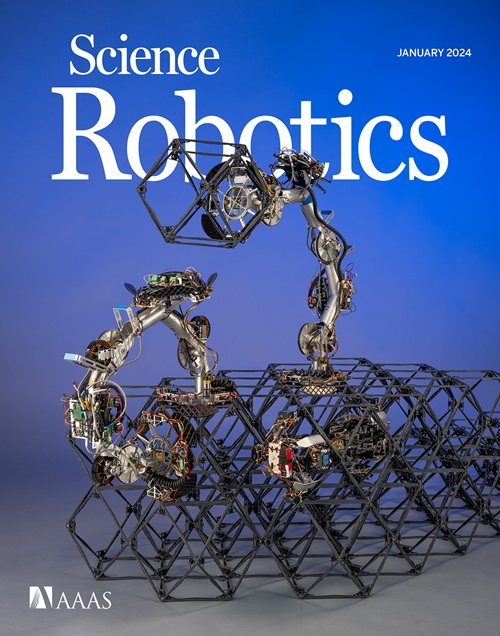复杂离散地形下四足机器人的高速控制与导航
IF 27.5
1区 计算机科学
Q1 ROBOTICS
引用次数: 0
摘要
在离散和几何复杂的环境中,高速腿式导航是一项具有挑战性的任务,因为该优化问题具有高自由度动力学和长视界的非凸性。在这项工作中,我们为有腿机器人提出了一种分层导航管道,可以高速穿越这些环境。建议的管道由计划器和跟踪器模块组成。规划模块利用启发式算法和神经网络,通过基于采样的快速顺序滤波优化,找到物理上可行的立足点规划。随后,在物理模拟中进行部署,以确定有关工程成本函数的最佳立足点计划,并确认其物理一致性。这种分层规划模块在计算效率和物理精度的同时。跟踪器旨在从规划模块准确地踩到目标立足点。在训练阶段,由与跟踪器竞争训练的生成模型给出落脚点目标分布。此过程确保跟踪器在具有所需难度的环境中进行训练。由此产生的跟踪器可以克服比以前的方法更困难的地形。我们用内部动态四足机器人Raibo演示了我们的方法。结果是动态和敏捷的运动:Raibo能够在垂直的墙壁上跑步,跳过1.3米的缝隙,以每秒4米的速度跑过台阶,并在充满30°斜坡,楼梯和各种大小的盒子的地形上自主导航。本文章由计算机程序翻译,如有差异,请以英文原文为准。
High-speed control and navigation for quadrupedal robots on complex and discrete terrain
High-speed legged navigation in discrete and geometrically complex environments is a challenging task because of the high–degree-of-freedom dynamics and long-horizon, nonconvex nature of the optimization problem. In this work, we propose a hierarchical navigation pipeline for legged robots that can traverse such environments at high speed. The proposed pipeline consists of a planner and tracker module. The planner module finds physically feasible foothold plans by sampling-based optimization with fast sequential filtering using heuristics and a neural network. Subsequently, rollouts are performed in a physics simulation to identify the best foothold plan regarding the engineered cost function and to confirm its physical consistency. This hierarchical planning module is computationally efficient and physically accurate at the same time. The tracker aims to accurately step on the target footholds from the planning module. During the training stage, the foothold target distribution is given by a generative model that is trained competitively with the tracker. This process ensures that the tracker is trained in an environment with the desired difficulty. The resulting tracker can overcome terrains that are more difficult than what the previous methods could manage. We demonstrated our approach using Raibo, our in-house dynamic quadruped robot. The results were dynamic and agile motions: Raibo is capable of running on vertical walls, jumping a 1.3-meter gap, running over stepping stones at 4 meters per second, and autonomously navigating on terrains full of 30° ramps, stairs, and boxes of various sizes.
求助全文
通过发布文献求助,成功后即可免费获取论文全文。
去求助
来源期刊

Science Robotics
Mathematics-Control and Optimization
CiteScore
30.60
自引率
2.80%
发文量
83
期刊介绍:
Science Robotics publishes original, peer-reviewed, science- or engineering-based research articles that advance the field of robotics. The journal also features editor-commissioned Reviews. An international team of academic editors holds Science Robotics articles to the same high-quality standard that is the hallmark of the Science family of journals.
Sub-topics include: actuators, advanced materials, artificial Intelligence, autonomous vehicles, bio-inspired design, exoskeletons, fabrication, field robotics, human-robot interaction, humanoids, industrial robotics, kinematics, machine learning, material science, medical technology, motion planning and control, micro- and nano-robotics, multi-robot control, sensors, service robotics, social and ethical issues, soft robotics, and space, planetary and undersea exploration.
 求助内容:
求助内容: 应助结果提醒方式:
应助结果提醒方式:


